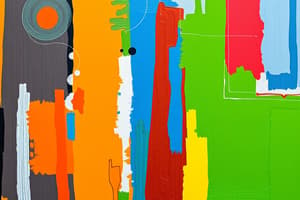Podcast
Questions and Answers
How does the bit depth of an image affect its file size?
How does the bit depth of an image affect its file size?
- Lower bit depth leads to larger file sizes because of increased color quantization.
- File size is independent of both bit depth and color quantization techniques.
- Bit depth does not influence file size; only image dimensions matter.
- Higher bit depth leads to larger file sizes due to more color information. (correct)
What consequence does color quantization have on an image?
What consequence does color quantization have on an image?
- It may cause different original colors to map to the same color, losing image fidelity. (correct)
- It reduces file size without affecting the visual quality of the image.
- It eliminates all color differences, leading to a monochromatic image.
- It enhances the image by increasing the number of colors available.
Which statement accurately describes the relationship between bit depth and color representation?
Which statement accurately describes the relationship between bit depth and color representation?
- The number of colors represented is always twice the value of the bit depth.
- A 24-bit image can represent 16,777,216 colors. (correct)
- A 2-bit digital image can represent 256 colors.
- A 8-bit image supports only 64 colors.
What is a critical factor for image fidelity besides bit depth?
What is a critical factor for image fidelity besides bit depth?
What is a defining characteristic of bitmap images?
What is a defining characteristic of bitmap images?
How does increasing the bit depth affect image fidelity?
How does increasing the bit depth affect image fidelity?
What is a limitation of using lower bit depth in images?
What is a limitation of using lower bit depth in images?
Which of the following statements about bitmap images is true?
Which of the following statements about bitmap images is true?
How does increasing the bit depth of an image affect its file size?
How does increasing the bit depth of an image affect its file size?
Which of the following statements accurately describes bitmap images?
Which of the following statements accurately describes bitmap images?
What is one consequence of aliasing in digital imaging?
What is one consequence of aliasing in digital imaging?
What impact does increasing the sampling rate have on image fidelity?
What impact does increasing the sampling rate have on image fidelity?
Which color model is predominantly used in digital imaging to represent colors as varying intensities of red, green, and blue?
Which color model is predominantly used in digital imaging to represent colors as varying intensities of red, green, and blue?
What is the primary functionality of color quantization in digital imaging?
What is the primary functionality of color quantization in digital imaging?
What is one disadvantage of using vector graphics compared to bitmap images?
What is one disadvantage of using vector graphics compared to bitmap images?
How does an increased bit depth specifically affect the representation of colors in an image?
How does an increased bit depth specifically affect the representation of colors in an image?
What is the file size in bytes for an image of 1500 × 1000 pixels with a color depth of 24 bits?
What is the file size in bytes for an image of 1500 × 1000 pixels with a color depth of 24 bits?
Which statement best describes the impact of reducing an image's bit depth from 24-bit to 8-bit?
Which statement best describes the impact of reducing an image's bit depth from 24-bit to 8-bit?
How can the file size of an image be effectively reduced?
How can the file size of an image be effectively reduced?
In the context of bitmap versus vector graphics, which statement is true?
In the context of bitmap versus vector graphics, which statement is true?
Which pixel dimensions yield a file size of 48,000,000 bits when multiplied by 8 bits per pixel?
Which pixel dimensions yield a file size of 48,000,000 bits when multiplied by 8 bits per pixel?
What is a consequence of using an 8-bit color depth?
What is a consequence of using an 8-bit color depth?
For grayscale images, what is the maximum bit depth that can be effectively used without quality loss?
For grayscale images, what is the maximum bit depth that can be effectively used without quality loss?
What happens to an image's quality when reducing its pixel dimensions?
What happens to an image's quality when reducing its pixel dimensions?
Flashcards are hidden until you start studying
Study Notes
Consequences of Quantization
- Color reduction in images can result in multiple original colors being mapped to the same color, leading to fidelity loss.
- Details relying on subtle color differences can be diminished during quantization.
- For example, a 4-color image may present an area with only one color instead of multiple shades.
Bit Depth
- Bit depth determines the number of colors that can be represented in an image, expressed as 2^n.
- A 2-bit image supports 4 colors; an 8-bit image supports 256 colors.
- The most common bit depth is 24-bit, allowing for 16,777,216 colors.
Impact of Color Palette on Image Fidelity
- A higher number of colors does not consistently equate to improved image fidelity.
- The selection of colors for quantization is critical for accurate image reproduction.
- While higher bit depth provides more color representation, it also increases file size.
Bitmapped Image Characteristics
- Bitmap images consist of a grid where each cell, or pixel, holds a single color value.
- Resolution is fixed, and the image detail level is determined by the pixel count.
- Pixel examples include:
- 3000 x 2000 pixels = 6,000,000 pixels
- 1500 x 1000 pixels = 1,500,000 pixels
- File size calculations:
- 3000 x 2000 at 24 bits = 144,000,000 bits (≈ 17MB)
- 1500 x 1000 at 24 bits = 36,000,000 bits (≈ 4.3MB)
- 3000 x 2000 at 8 bits = 48,000,000 bits (≈ 5.7MB)
Strategies to Reduce File Size
- Capture images at lower resolutions to reduce pixel dimensions.
- Lower the bit depth when resampling images.
- Compress file sizes for efficient storage.
Bit Depth vs. File Size
- Reducing from 24-bit to 8-bit loses about 16 million colors, potentially degrading image quality.
- 8-bit depth may suffice for images needing only 256 colors, such as grayscale or scanned documents.
- Higher bit depths (e.g., 24-bit) are necessary for richer color images.
Learning Objectives
- Understand digitizing images and the digitization process.
- Explore the effects of pixels, resolution, and bit depth on image fidelity and detail.
- Differentiate between bitmap images and vector graphics.
- Define aliasing and anti-aliasing concepts.
- Assess how pixel dimensions and bit depth impact image file size.
- Identify various color models and their color representation.
Pegboard Analogy (Digital Sampling)
- Each peg hole in a pegboard represents a discrete sample point, analogous to a pixel in imaging.
- Increasing the sampling rate by adjusting from a 25x20 grid to a 100x80 grid enhances detail capture.
Resolution
- Higher sampling rates correlate with increased image resolution.
- More pixels allow for finer detail representation and a larger file size of the digitized image.
Quantization
- Quantization encodes infinite colors and shades using a finite list by mapping pixel colors to discrete values.
- Deciding on the potential colors for the image is essential before quantization.
Studying That Suits You
Use AI to generate personalized quizzes and flashcards to suit your learning preferences.




